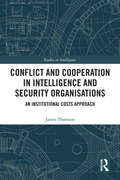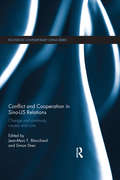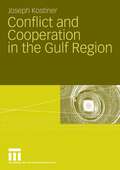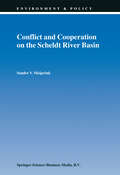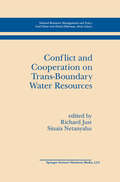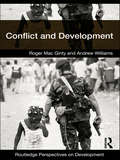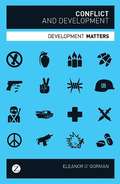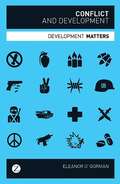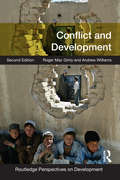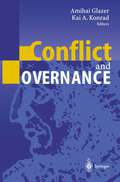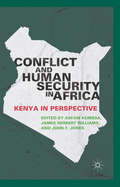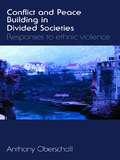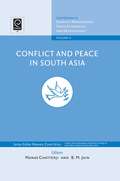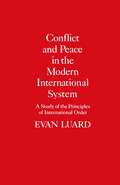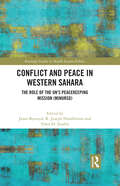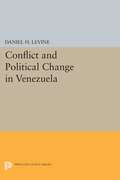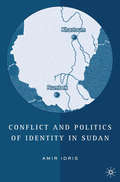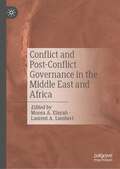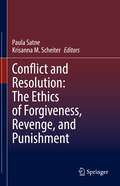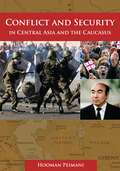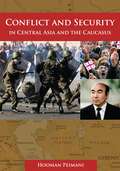- Table View
- List View
Conflict and Cooperation in Intelligence and Security Organisations: An Institutional Costs Approach (Studies in Intelligence)
by James ThomsonThis book provides an institutional costs framework for intelligence and security communities to examine the factors that can encourage or obstruct cooperation. The governmental functions of security and intelligence require various organisations to interact in a symbiotic way. These organisations must constantly negotiate with each other to establish who should address which issue and with what resources. By coupling adapted versions of transaction costs theories with socio-political perspectives, this book provides a model to explain why some cooperative endeavours are successful, whilst others fail. This framework is applied to counterterrorism and defence intelligence in the UK and the US to demonstrate that the view of good cooperation in the former and poor cooperation in the latter is overly simplistic. Neither is necessarily more disposed to behave cooperatively than the other; rather, the institutional costs created by their respective organisational architectures incentivise different cooperative behaviour in different circumstances. This book will be of much interest to students of intelligence studies, organisational studies, politics and security studies.
Conflict and Cooperation in Sino-US Relations: Change and Continuity, Causes and Cures (Routledge Contemporary China Series)
by Jean-Marc F. Blanchard Simon ShenNumerous crosswinds are buffeting the more than 40-year-old People's Republic of China--American relationship, yet only once since Nixon’s historic trip to China in 1972 has a major conflagration seemed a real possibility. Anchoring the relationship throughout multiple storms are the two countries’ broad areas of collaboration such as deep links in culture, economics, and education. However, for some observers, the conflictual aspects of the relationship seem to be gaining prominence. Conflict and Cooperation in Sino-US Relations offers a timely and current look at one of the world’s weightiest bilateral relationships. It goes beyond detailing the conflict and cooperation that have been integral facets of China--US interactions since 1972, to gauging the relationship's evolution and future trends, examining its nuances regarding diverse issues such as the Asia-Pacific leadership structure, the South China Sea, and the Korean peninsula. The book further delves into the causes of conflict and cooperation, offers diverse solutions for tempering frictions between Beijing and Washington, and considers the efficacy of some of the mechanisms (e.g., military-to-military exchanges) that China and the US currently employ to manage their relationship.The chapters suggest that extreme anxieties about China--US relations may be misplaced, but that there nonetheless are some worrisome signs even in areas like economics and the environment that are perceived as naturally cooperative. While the book does not offer any silver bullets, various contributors contend that successful management of Sino-American relations may require greater American accommodation of China’s interests. This book will be of great interest to students and scholars of Chinese politics, American politics, international relations, and Asian studies, as well as to policy-makers working in the field.
Conflict and Cooperation in Sino-US Relations: Change and Continuity, Causes and Cures (Routledge Contemporary China Series)
by Jean-Marc F. Blanchard Simon ShenNumerous crosswinds are buffeting the more than 40-year-old People's Republic of China--American relationship, yet only once since Nixon’s historic trip to China in 1972 has a major conflagration seemed a real possibility. Anchoring the relationship throughout multiple storms are the two countries’ broad areas of collaboration such as deep links in culture, economics, and education. However, for some observers, the conflictual aspects of the relationship seem to be gaining prominence. Conflict and Cooperation in Sino-US Relations offers a timely and current look at one of the world’s weightiest bilateral relationships. It goes beyond detailing the conflict and cooperation that have been integral facets of China--US interactions since 1972, to gauging the relationship's evolution and future trends, examining its nuances regarding diverse issues such as the Asia-Pacific leadership structure, the South China Sea, and the Korean peninsula. The book further delves into the causes of conflict and cooperation, offers diverse solutions for tempering frictions between Beijing and Washington, and considers the efficacy of some of the mechanisms (e.g., military-to-military exchanges) that China and the US currently employ to manage their relationship.The chapters suggest that extreme anxieties about China--US relations may be misplaced, but that there nonetheless are some worrisome signs even in areas like economics and the environment that are perceived as naturally cooperative. While the book does not offer any silver bullets, various contributors contend that successful management of Sino-American relations may require greater American accommodation of China’s interests. This book will be of great interest to students and scholars of Chinese politics, American politics, international relations, and Asian studies, as well as to policy-makers working in the field.
Conflict and Cooperation in the Gulf Region
by Joseph KostinerThis book analyzes four main episodes of conflict and defense which have affected the region during the last three decades: the Iran-Iraq war (1980-1988), which effected the Gulf Cooperation Council (GCC) from a close, neighborly distance; the Iraq-Kuwait war (1990-1991), which constituted an attempt to invade the GCC and eliminate one of its member states, Kuwait. And the subsequent attempts to reestahblish a regional inter-state stability in the Gulf (during the mid-1990s, approximately), and the war of Islamic terrorism (notably al-Qa'ida) against Saudi Arabia (leading up to 2005). Each episode was driven by inimical interests and evolved as a distabilizintg influence on the Gulf states. At the same time, each conflict resulted in a paradoxical combination rivalry and cooperation among the GCC states themselves. A perpetual sequence of conflict and cooperation thus developed.
Conflict and Cooperation on the Scheldt River Basin: A Case Study of Decision Making on International Scheldt Issues between 1967 and 1997 (Environment & Policy #17)
by S.V. MeijerinkMore than 200 major river basins are shared by two or more countries and, together, these basins account for about 60% of the earth's land area, constituting a significant portion of the world's fresh water resources. They are thus both a significant asset to the nations sharing them, as well as a potential source of conflict. This book presents a generic framework for the analysis of decision making on international river issues. It emphasises the strategic character of the interactions between the basin states and addresses learning and institutionalization processes, taking account of the influence of the context on the decision making process. The case of the river Scheldt covers negotiations on the Belgian-Dutch water conventions covering a number of international issues relating to the river basins of the Scheldt and the Meuse, such as construction projects aimed at improving the maritime access to the port of Antwerp, the maintenance of the navigation channel in the Western Scheldt, pollution of the waters in the two rivers, and the distribution of water from the Meuse. The final part of the book contains a typology of strategies for the solution of upstream-downstream problems in international river basins. Audience: All those interested in international water and environmental management, international negotiations and politics, and public policy.
Conflict and Cooperation on Trans-Boundary Water Resources (Natural Resource Management and Policy #11)
by Richard E. Just Sinaia NetanyahuThis book demonstrates what the discipline of economics has to offer as support for analyzing cooperation on management of trans-boundary water resources. It also considers what the discipline of economics has to acquire to become a more effective contributor to trans-boundary water resource management given political, legal, social, physical, scientific, and ecological realities. This book has its genesis in a symposium of the International Water and Resource Economics Consortium held at Annapolis, Maryland, April 13-16, 1997. The symposium was organized by the editors and the book contains papers presented at the symposium with subsequent revisions. The symposium brought together both economists and agency management personnel for the purpose of discussing not only how economic tools apply to trans-boundary water management, but also of identifying the obstacles to making such tools useful and informative to politicians and negotiators in public decision making roles. INTERNATIONAL VERSUS DOMESTIC TRANS-BOUNDARY PROBLEMS Trans-boundary water problems arise in many dimensions. The two most important types of problems emphasized in this book are international and domestic interstate or interregional problems. Cooperation on international problems is especially difficult because enforcement must be voluntary given the sovereignty of nations and the absence of an effective legal enforcement mechanism. Agreements must be sustainable and self-enforced if they are to have lasting benefits. Every negotiating country must be convinced it will receive benefits before it gives its consent to cooperation. In the absence of enforceable agreements, trans-boundary (i. e.
Conflict and Development
by Roger Mac Ginty Andrew WilliamsOver the past decade, a new awareness of the relationship between conflicts and development has grown. Developmental factors can act as a trigger for violence, as well as for ending violence and for triggering post-conflict reconstruction. This book explores the complexity of the links between violent conflict (usually civil wars) and development, under-development and uneven development. It emphasizes the connections between stable developed economies and civil wars in other parts of the world, and examines how structural factors (such as the organization of the global economy) virtually condemn some regions to conflict and under-development. This valuable introductory text explains, reviews and critically evaluates this complex relationship. It focuses on intra-state conflicts and complex political emergencies that combine transnational and internal characteristics. Attention is also given to inter-state conflicts. Chapters emphasize how the relationship between conflict and development traverses many scales (macro, meso and micro) and dimensions (economic, political and cultural). Furthermore it explains how different developmental challenges and opportunities emerge along the full life-cycle of conflict. Specifically, the role of poverty, state, market, civil society, globalization, humanitarian aid, refuges, gender and health within conflict dynamics are examined. The book also investigates specific developmental issues emerging during conflict management and post conflict reconstruction. Both authors have a background in conducting research in deeply divided societies, and argue that many of the processes connected with war and peace making deliberately write people out of the equation. This book attempts to ‘write people in’. By drawing on contemporary theoretical debates and examining current policies and events, the text unpacks the difficult and complex aspects of the relationships between armed conflict and development and makes them accessible, interesting and policy relevant. It considers how peace making, peace building, and post-war reconstruction are usually more sustainable and successful if politicians, policy makers, entrepreneurs and those working for international NGOs take on board local opinion and capacity. Written in an accessible style, the book considers the main contemporary theories and arguments on conflict, development and the interactions between the two. The text is illuminated throughout with case studies drawn from Africa, the Balkans, Asia and the Middle East.
Conflict and Development (Development Matters)
by Eleanor O' GormanDuring the 1990s the drive of liberal peace efforts in the form of humanitarian intervention transformed the ways in which traditional development assistance operated in war and post-war situations. From Somalia and Rwanda to Bosnia and Sri Lanka, conflict, security and development became more intertwined as more integrated programmes and interventions were advocated by the international community.Conflict and Development, whilst serving as an in-depth introduction to key themes and context, questions the extent to which international aid has over-reached in seeking to engage more centrally in addressing the causes and consequences of violent conflict. Using this framework, the author traces the evolution of the conflict and development agenda and explores the politics of aid and policymaking in relation to international conflict.By taking a combined approach of theory, policy and practice this vital new book explores and comprehensively explains the impact of conflict on development and vice-versa through the series of concise thematic chapters.
Conflict and Development (Development Matters)
by Eleanor O' GormanDuring the 1990s the drive of liberal peace efforts in the form of humanitarian intervention transformed the ways in which traditional development assistance operated in war and post-war situations. From Somalia and Rwanda to Bosnia and Sri Lanka, conflict, security and development became more intertwined as more integrated programmes and interventions were advocated by the international community.Conflict and Development, whilst serving as an in-depth introduction to key themes and context, questions the extent to which international aid has over-reached in seeking to engage more centrally in addressing the causes and consequences of violent conflict. Using this framework, the author traces the evolution of the conflict and development agenda and explores the politics of aid and policymaking in relation to international conflict.By taking a combined approach of theory, policy and practice this vital new book explores and comprehensively explains the impact of conflict on development and vice-versa through the series of concise thematic chapters.
Conflict and Development (Routledge Perspectives on Development)
by Andrew Williams Roger Mac GintyIn the five years since the first edition of Conflict and Development was published the awareness of the relationship between conflicts and development has grown exponentially. Developmental factors can act as a trigger for violence, as well as for ending violence and for triggering post-conflict reconstruction. The book explores the complexity of the links between violent conflict (usually civil wars) and development, under-development and uneven development. The second edition incorporates significant changes in the field including the G7+ initiative, the New Deal on Fragile States, World Trade talks, major policy documents from the UNDP and World Bank and updates on the Afghanistan and Iraq wars.
Conflict and Development (Routledge Perspectives on Development)
by Andrew Williams Roger Mac GintyIn the five years since the first edition of Conflict and Development was published the awareness of the relationship between conflicts and development has grown exponentially. Developmental factors can act as a trigger for violence, as well as for ending violence and for triggering post-conflict reconstruction. The book explores the complexity of the links between violent conflict (usually civil wars) and development, under-development and uneven development. The second edition incorporates significant changes in the field including the G7+ initiative, the New Deal on Fragile States, World Trade talks, major policy documents from the UNDP and World Bank and updates on the Afghanistan and Iraq wars.
Conflict and Governance
by Amihai Glazer Kai A. KonradConflict appears in many forms, from a dictator terrorizing his country to organized crime demanding protection money. Questions and issues addressed in this text include: the conditions which make conflict severe; whether voluntary agreements can avoid future conflict; how the outcome of one war will affect the incentives of countries to wage war in the future; and how dictators hold power. The book provides an overview of existing literature, applies the theory of conflict to new situations, and gives foundations for future work. It should interest both researchers and students studying political economy, public choice, international relations, and comparative politics.
Conflict and Human Security in Africa: Kenya in Perspective
by A. Kumssa J. Williams J. JonesThis edited volume looks at human security and conflict in northern Kenya and nearby areas within Sudan, Somalia, Ethiopia, and Uganda. It spells out the precise meaning and nuances of human security in today's global economy and examines the causes and effects of conflict in the region within the context of human security.
Conflict and Peace Building in Divided Societies: Responses to Ethnic Violence
by Anthony OberschallThis groundbreaking book provides an integrated account of ethnic, nationality and sectarian conflicts in the contemporary world including the role of collective myths, the mass media and the ethnification of identities as contributors to ethnic conflicts and wars. In addition to many examples from the last two decades, Oberschall provides a comprehensive overview of the conflict and peace processes in Bosnia, Northern Ireland and the Middle East. Oberschall analyzes: peace building through constitutional design power sharing governance disarming combatants, post-accord security and refugee return transitional justice (truth and reconciliation commissions, war crimes tribunals) economic and social reconstruction in a multiethnic society. In addition to many examples from the last two decades, Oberschall provides a comprehensive overview of the conflict and peace processes for Bosnia, Northern Ireland, and Israel-Palestinians. He argues that insurgency creates contentious issues over and above the original root causes of the conflict, that the internal divisions within the adversaries trigger conflicts that jeopardize peace processes, and that security and rebuilding a failed state are a precondition for lasting peace and a democratic polity. This book will be essential reading for undergraduate and postgraduate students, researchers and academics interested in the fields of peace studies, war and conflict studies, ethnic studies and political sociology.
Conflict and Peace Building in Divided Societies: Responses to Ethnic Violence
by Anthony OberschallThis groundbreaking book provides an integrated account of ethnic, nationality and sectarian conflicts in the contemporary world including the role of collective myths, the mass media and the ethnification of identities as contributors to ethnic conflicts and wars. In addition to many examples from the last two decades, Oberschall provides a comprehensive overview of the conflict and peace processes in Bosnia, Northern Ireland and the Middle East. Oberschall analyzes: peace building through constitutional design power sharing governance disarming combatants, post-accord security and refugee return transitional justice (truth and reconciliation commissions, war crimes tribunals) economic and social reconstruction in a multiethnic society. In addition to many examples from the last two decades, Oberschall provides a comprehensive overview of the conflict and peace processes for Bosnia, Northern Ireland, and Israel-Palestinians. He argues that insurgency creates contentious issues over and above the original root causes of the conflict, that the internal divisions within the adversaries trigger conflicts that jeopardize peace processes, and that security and rebuilding a failed state are a precondition for lasting peace and a democratic polity. This book will be essential reading for undergraduate and postgraduate students, researchers and academics interested in the fields of peace studies, war and conflict studies, ethnic studies and political sociology.
Conflict and Peace in South Asia (Contributions to Conflict Management, Peace Economics and Development #5)
by Manas Chatterji B. M. JainSouth Asia is a distinct geographical entity comprised of seven countries - India, Pakistan, Bangladesh, Nepal, Bhutan, Sri Lanka and Maldives (situated in the Indian Ocean). The region, as discussed in the contributions to this volume, is turning out to be the most dangerous place in the world, representing a breeding ground of bloody terror and radical extremism exemplified by the assassination of Benazir Bhutto, of Pakistan, in December 2007.India and Pakistan have been involved in a never-ending conflict over Kashmir since the sub-continent was divided in 1947, and have been involved in numerous wars and superpower games. The situation has now become alarming since both countries possess nuclear arms, religious extremism has spread, and there is increased internal ethnic fighting (particularly in Pakistan). Pakistan, often described as a failed state, is experimenting with democracy with serious internal and external results. Bangladesh, oscillating between brief periods of democracy and military dictatorship, is becoming a center for religious extremism, and poses serious problems for India due to illegal immigration. In Nepal, the monarchy has been abolished and a left-wing Maoist government has taken hold. For the last twenty years, Sri Lanka has been involved in a bloody civil war. Even Bhutan and Maldives experience security and internal problems. The chapters in this book look at these countries in a historical context, from inter-regional and international perspectives. Conflict and peace in South Asia connect with a diverse array of factors, ranging from poverty, nuclear proliferation, heavy military expenditure at the expense of development and social goods, militancy, insurgency, illegal migration, environmental degradation, resource depletion, child labor, gender discrimination, and so on. Globalization has increased the income of the region's wealthy class segments and promoted inter-regional inequality. All these factors are interrelated. Accordingly, this volume includes papers that link socio-economic factors, resource constraints, and international trade to human security. Although most of the papers are case studies for individual countries, an attempt has been made in other papers to show how the quantitative methods of Peace Science can be used to analyze the region's situation and make predictions for the future.
Conflict and Peace in the Modern International System: A Study of the Principles of International Order (pdf)
by Evan LuardConflict and Peace in Western Sahara: The Role of the UN's Peacekeeping Mission (MINURSO) (Routledge Studies in Middle Eastern Politics)
by János Besenyő R. Joseph Huddleston Yahia H. ZoubirThis book offers the first comprehensive analysis of MINURSO (the United Nations Mission for the Referendum in Western Sahara), focused on its activities, composition, purpose, and operational future in Western Sahara, the world’s last colony. The book’s focus is broad, examining MINURSO from key historical, legal, military and political angles whilst assessing the future of UN peacekeeping missions in the Western Sahara. Supported by a diverse, international mix of perspectives and professions—including academics, lawyers, soldiers, and humanitarian aid workers—an in-depth view of MINURSO is provided, rooted in practical Western Saharan field experience. The authors reveal the complexities of the region and of the mission locally, but also analyze MINURSO through a global lens, focusing on relations with the United States, China, Russia, France, and African states. This approach emphasizes the importance of the region as a site of international struggle while remaining conscious of local contexts. A landmark contribution to peacekeeping studies, the book is vital reading for practitioners and academics focused on the Western Saharan conflict and the MENA region, but will also be of interest to those engaged in international relations, international law, and security studies.
Conflict and Peace in Western Sahara: The Role of the UN's Peacekeeping Mission (MINURSO) (Routledge Studies in Middle Eastern Politics)
by Yahia H. Zoubir János Beseny 337 R. Joseph HuddlestonThis book offers the first comprehensive analysis of MINURSO (the United Nations Mission for the Referendum in Western Sahara), focused on its activities, composition, purpose, and operational future in Western Sahara, the world’s last colony. The book’s focus is broad, examining MINURSO from key historical, legal, military and political angles whilst assessing the future of UN peacekeeping missions in the Western Sahara. Supported by a diverse, international mix of perspectives and professions—including academics, lawyers, soldiers, and humanitarian aid workers—an in-depth view of MINURSO is provided, rooted in practical Western Saharan field experience. The authors reveal the complexities of the region and of the mission locally, but also analyze MINURSO through a global lens, focusing on relations with the United States, China, Russia, France, and African states. This approach emphasizes the importance of the region as a site of international struggle while remaining conscious of local contexts. A landmark contribution to peacekeeping studies, the book is vital reading for practitioners and academics focused on the Western Saharan conflict and the MENA region, but will also be of interest to those engaged in international relations, international law, and security studies.
Conflict and Political Change in Venezuela (PDF)
by Daniel H. LevineVenezuela has had a long and bloody history of military dictatorships. Yet, since 1958, it has developed one of the few effective, competitive democracies in Latin America. To explain this transformation Daniel H. Levine analyzes the development of modern mass-based political parties with pervasive organizations and commanding strong loyalties; the changing structure and content of social and political conflict; and the gradual emergence of common norms governing political behavior.This book does not pretend to be a general survey of Venezuelan politics. Rather, it is an attempt to understand, for both theoretical and practical purposes, the development of shared "rules of the game" for political action in a heterogeneous society. Once these norms are accepted by key elites, and then imposed on recalcitrant oppositions, they provide a means of controlling and managing political conflict without eliminating it.Mr. Levine's conclusions are based primarily on case studies of specific political conflicts. His study of conflicts over educational reform uncovers the conditions in which a traditional sector of society—Catholic groups and institutions—moved from violent, total opposition to the political system to a position of accommodation. In the second case study he examines the role of students in politics, with special reference to the integration of students in national patterns of conflict and opposition.Originally published in 1973.The Princeton Legacy Library uses the latest print-on-demand technology to again make available previously out-of-print books from the distinguished backlist of Princeton University Press. These editions preserve the original texts of these important books while presenting them in durable paperback and hardcover editions. The goal of the Princeton Legacy Library is to vastly increase access to the rich scholarly heritage found in the thousands of books published by Princeton University Press since its founding in 1905.
Conflict and Politics of Identity in Sudan
by A. IdrisThis book explores the relationship between state formation and political identities in the context of Sudan's conflict. Idris examines how hierarchy was historically constructed and politically institutionalized in the Sudan, acknowledging the centrality of the historical legacy of slavery and colonialism in Sudan's postcolonial crisis
Conflict and Post-Conflict Governance in the Middle East and Africa
by Moosa A. Elayah Laurent A. LambertThis book explores the challenges of the governance and public policy in the midst and after conflicts, revolutions, and civil wars in the Middle East and Africa. As anywhere else, the task of rebuilding peace and institutionalizing stability in countries experiencing a conflict or just emerging from it is daunting, uncertain and context specific. Yet, focusing on the Middle East and Africa is of particular relevance, as these two regions feature the highest numbers of inter- and intra-state conflicts on the one hand, and the central states are more often contested than in the rest of world regions. The first half of the book proposes different cases addressing the fundamental challenge of inclusion and cohesion as well as the recurring issue of exclusion in conflict-affected situations, with four different cultural and institutional settings. The second half of the book offers more theoretical insights and proposed pathways to develop more inclusive and peaceful governance settings in Africa, the Middle East and beyond. This edited book has been designed to be a helpful contribution to the analysis of conflict and post-conflict governance and peacebuilding. To do so, it deploys different lenses of social sciences, especially public policy and international relations, but also benefits from social psychology, political anthropology, and other disciplines that enable a more comprehensive understanding of the multifaceted, complex and dynamic issues at play.
Conflict and Resolution: The Ethics of Forgiveness, Revenge, and Punishment
by Paula Satne Krisanna M. ScheiterGiven the current climate of political division and global conflict it is not surprising that there has been an increasing interest in how we ought to respond to perceived wrongdoing, both personal and political. In this volume, top scholars from around the world contribute all new original essays on the ethics of forgiveness, revenge, and punishment. This book draws on both historical and contemporary debates in order to answer important questions about the nature of forgiveness, the power of apology, the relationship between punishment and revenge, the path to reconciliation, the morality of blame, and the role of forgiveness in political conflict.Chapter 16 is available open access under a Creative Commons Attribution 4.0 International License via link.springer.com.
Conflict and Security in Central Asia and the Caucasus
by Hooman PeimaniThis is the only book since the fall of the Soviet Union to analyze the security of the newly emerged independent states in the strategically vital region of Central Asia and the Caucasus.This insightful work maps out the possibilities and dangers that lie ahead for the nations of Central Asia and the Caucasus. The book analyzes the current security situation and clarifies its historical context, identifying the factors that have shaped the security of these young nations since their independence. It also examines the parameters—political, economic, ethnic, energy, and military—that will decide the security of the region in the future.The book's author tells the whole story behind the headlines when he discusses, for example, the real reason for the "wine war" of 2006, when Russia banned imports of Georgian wine for "health reasons," or when explaining the impact of the expanding American presence—both political and military—after September 11. Conflict and Security in Central Asia and the Caucasus is a primer for those who want to know more about this strategic region and essential reading for all students of world affairs.
Conflict and Security in Central Asia and the Caucasus
by Hooman PeimaniThis is the only book since the fall of the Soviet Union to analyze the security of the newly emerged independent states in the strategically vital region of Central Asia and the Caucasus.This insightful work maps out the possibilities and dangers that lie ahead for the nations of Central Asia and the Caucasus. The book analyzes the current security situation and clarifies its historical context, identifying the factors that have shaped the security of these young nations since their independence. It also examines the parameters—political, economic, ethnic, energy, and military—that will decide the security of the region in the future.The book's author tells the whole story behind the headlines when he discusses, for example, the real reason for the "wine war" of 2006, when Russia banned imports of Georgian wine for "health reasons," or when explaining the impact of the expanding American presence—both political and military—after September 11. Conflict and Security in Central Asia and the Caucasus is a primer for those who want to know more about this strategic region and essential reading for all students of world affairs.
